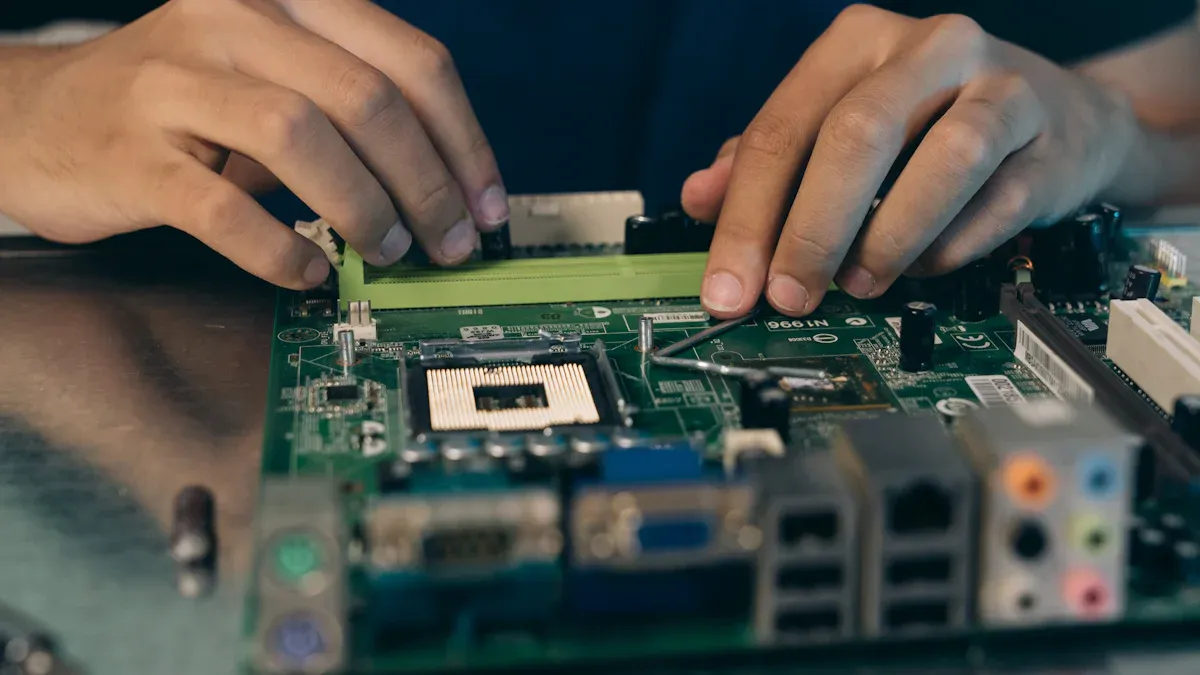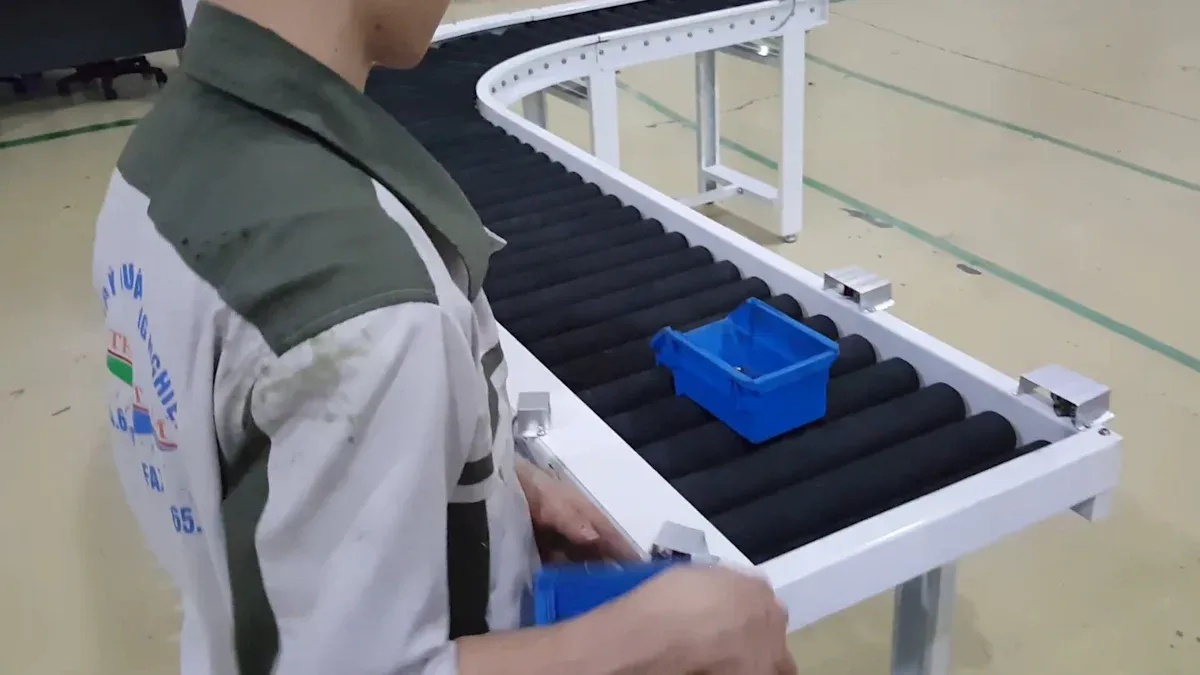
Workflow efficiency is very important in PCBA manufacturing. It impacts how fast and well you make circuit boards. Better efficiency lowers costs, increases work speed, and improves solder quality. Focusing on design, tools, and steps makes work smoother. Using new technology and training workers helps even more. Every small change leads to better results and stronger competition in the market.
Key Takeaways
Arrange your PCB layout to avoid errors and work faster. Place parts wisely and keep space between them.
Include test points in your PCB design. This finds problems early and makes quality better.
Use new machines and automation. Robots do repeated tasks faster and more precisely.
Train your workers often. Training helps them stay skilled and learn new tools.
Use Industry 4.0 tech. AI and IoT can track production live and spot machine problems early.
Make PCB Design Easier to Build
Changing how your circuit board is designed can make it easier to build and improve how well it works. By designing for easy manufacturing, you can fix mistakes, save money, and make assembly smoother. Here are three ways to make PCB design better.
Organize PCB Layout and Place Parts Smartly
A neat PCB layout makes building easier and reduces mistakes. To do this:
Put surface-mount parts on one side of the board. This makes building simpler and improves results.
Line up all surface-mount parts in the same way. This helps machines work faster and check for mistakes better.
Don’t crowd parts together. This makes testing and fixing problems easier and lowers errors.
By organizing the layout, you make work faster and prepare for good assembly.
Add Test Points for Better Checking
Adding test points to your PCB helps find problems early. Test points let machines check connections and spot issues quickly. The table below shows why test points are helpful:
Benefit | What It Does |
|---|---|
Better Checking Accuracy | Special methods make inspections more exact. |
Fewer Problems After Making | Quick fixes stop big problems later. |
Stronger Quality Control | Using real data helps find and fix issues better. |
Adding test points makes sure your quality checks work well, making your boards more reliable.
Keep Designs Simple to Avoid Problems
Simple designs mean fewer mistakes and better results the first time. PCB complexity depends on layers, part amount, and wiring. The table below shows how these affect difficulty:
Factor | Easy (1) | Medium (2) | Hard (3) |
|---|---|---|---|
Number of Layers | 1-4 layers | 5-8 layers | 9+ layers |
Part Amount | Less than 10 parts | 10-20 parts | More than 20 parts |
Wiring Density | Low density | Medium density | High density |
Special Features | None | Some features | Many features |
Using fewer layers and spreading out parts makes designs simpler. This lowers mistakes and makes building easier. Good materials also make boards stronger.
By following these tips, you can make PCB designs easier to build, saving time and money.
Use Modern Machines for Better Production
In PCBA, modern machines help make work faster and better. Automating tasks, checking quality, and fixing machines often lead to smoother work and good results.
Let Robots Handle Repeated Work
Robots are great for doing the same tasks again and again. They make work faster, safer, and more accurate. For example:
Robots work with people to boost safety and speed.
They make things faster and cut setup time.
Working nonstop, they finish more and avoid delays.
A Deloitte report shows robots make factories faster and better. In five years, robots cut mistakes by 35% and made work 25% quicker. Adding robots is a smart choice for PCBA work.
Use Smart Tools to Check Quality
Smart tools help find mistakes early and keep quality high. These tools use new tech to spot problems and keep standards steady. A study shows using data helps improve how you check quality. By collecting info, testing ideas, and fixing steps, you can get better over time.
These tools also watch work live, so you can fix problems fast. This stops waste and keeps products top-notch.
Fix Machines Often to Avoid Stops
Fixing machines often keeps them working well and avoids stops. Predicting problems before they happen stops big issues. For example:
Fixing machines makes them last longer and break less.
It stops delays, saving time and money.
With fewer stops, work gets done faster and smoother.
Stops can cost money, miss deadlines, and hurt your name. Fixing machines on time keeps work steady and reliable.
Make PCBA Manufacturing Better
Making PCBA processes better can improve speed and reliability. By fixing soldering methods, using good materials, and adding control systems, you can lower mistakes and get steady results.
Fix Soldering Methods for Stronger Boards
Soldering is very important in PCBA work. Better soldering makes joints stronger, handles heat changes well, and lasts longer. These upgrades make boards work better in tough conditions.
Improvement Type | What It Does |
|---|---|
Stronger Joints | |
Handles Heat Changes | Works better when temperatures go up and down, stopping failures. |
Resists Heat Damage | Stays strong against heat damage, making boards last longer. |
Using these methods makes boards tougher and more reliable for your products.
Use Good Materials to Avoid Problems
Good materials help stop problems during assembly. Bad materials can cause weak joints or broken parts. Companies using better materials see big improvements:
Always improving keeps customers happy and ahead of others.
Testing shows how important quality checks are for success.
Better materials mean fewer problems and smoother manufacturing.
Add Control Systems for Steady Results
Control systems keep PCBA work steady and accurate. Machines like pick-and-place tools and inspection systems lower mistakes and keep quality high. Checking machines often and watching production helps catch problems early.
Tool/Method | How It Helps |
|---|---|
Quickly and accurately place parts, lowering mistakes. | |
Optical Inspection Tools | Spot problems better than manual checks. |
Reflow Soldering Machines | Keep soldering even, avoiding weak or overheated joints. |
Process Monitoring | Tracks production to find and fix issues early. |
Using these systems saves materials, keeps quality high, and makes work more efficient.
Integrate Industry 4.0 Technologies in PCBA

Use AI to Predict Problems and Improve Maintenance
AI can change how you take care of machines. It studies big data to find signs of possible machine issues. For example:
AI checks sensor data like heat and shaking to spot problems early.
It suggests when to fix machines based on live data, not just time.
This method avoids surprise breakdowns and makes machines last longer. You can plan repairs better, spend less on fixes, and work more efficiently.
Use IoT to Watch and Collect Data in Real Time
The IoT helps you track production as it happens. Sensors on machines send constant updates, helping you decide quickly. Here’s how IoT helps:
Smart decisions: Live data helps you plan repairs and use resources wisely.
Better visibility: IoT shows the whole process, making problem-solving easier.
Lower costs: Sensors predict issues, cutting repair needs and saving money.
Adding IoT gives you more control, smoother work, and better product quality.
Use Machine Learning to Make Processes Better
Machine learning (ML) improves work by studying data and guessing results. Digital twins let you test changes without stopping production. This helps you improve steps easily. Also:
AI tools check assembly steps, finding mistakes early and reducing waste.
Computer vision spots errors better, and special networks catch defects faster.
These tools cut costs, lower mistakes, and improve quality. Using ML keeps you ahead in the competitive PCBA industry.
Invest in Workforce Training and Development
Spending on worker training is a smart way to improve PCBA work. Skilled workers make fewer errors, work faster, and stay motivated. Regular training, learning new skills, and improving together build a strong team.
Hold Regular Training Sessions for Workers
Training often helps workers learn new tools and methods. It keeps them ready to handle tough tasks with confidence.
Training Focus | How It Helps |
|---|---|
Regular Training Sessions | Teaches workers about new tools and methods in PCBA. |
Skill Building | Improves abilities through classes and certifications. |
Training lowers mistakes and keeps product quality steady. Workers who learn often can adjust to changes quickly. This makes work smoother and saves money over time.
Teach Workers Different Skills
Teaching workers many skills helps them do more jobs. They can solve problems better and work with other teams.
Learning different skills helps workers fix problems faster. When issues happen during PCB work, skilled teams can solve them quickly. This avoids delays and improves results.
Cross-training also builds teamwork and flexibility. These are key for keeping work fast and efficient.
Encourage Always Getting Better
Making a workplace that values improvement leads to success. Motivate workers to try new tools, share ideas, and improve steps.
Research brings fresh ideas and eco-friendly solutions.
Working with others gives access to advanced tools and methods.
Training helps workers use new tools well.
By encouraging improvement, workers feel responsible for their jobs. This leads to better work and higher quality over time.
Making PCBA manufacturing more efficient needs a balanced plan. Work on improving PCB designs, using better machines, upgrading processes, adding smart technologies, and training workers. These steps help make products faster, with fewer mistakes, and better quality.
You can track the success of these steps with key measures:
Measure | What It Shows |
|---|---|
Part Placement Speed | How fast parts are placed on circuit boards |
Percent of products passing checks the first time | |
Total Production Time | Time from start to finish of making products |
Fewer Defects Over Time | How much defects have dropped over time |
Start using these ideas in your work. This will help you get steady results, save money, and stay ahead in the industry.
FAQ
What is SMT in PCB manufacturing?
SMT stands for Surface Mount Technology. It’s a way to attach parts directly onto a circuit board’s surface. This method makes production faster and assembly easier while keeping quality high.
How does the SMT assembly process improve production?
The SMT process uses machines to place parts, cutting down mistakes. It speeds up production and keeps quality steady. It also works well for compact designs, making products better and more reliable.
Why is regular maintenance important in PCBA production?
Regular maintenance stops sudden breakdowns and keeps machines running well. It lowers mistakes during assembly, keeps quality high, and helps machines last longer, saving money in the long run.
How can you ensure quality in PCB manufacturing?
To ensure quality, use good materials, add test points, and use smart inspection tools. Watching the process closely and using control systems also help keep standards high.
What role does workforce training play in improving assembly efficiency?
Training teaches workers how to use advanced tools and methods. It lowers mistakes, makes work faster, and keeps quality steady during assembly.
See Also
Enhancing Accuracy Through Automated PCBA Testing Methods
Innovative PCBA Testing Strategies for Modern Electronics Production
Choosing the Best PCBA Manufacturer for Your Business Growth
The Importance of PCBA Prototyping in Electronics Development
Understanding PCBA Services and Their Significance in Manufacturing